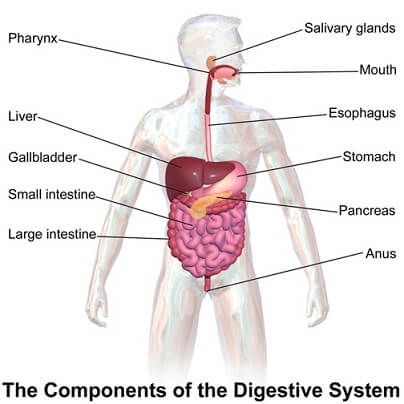Digestive system homework help
Are you in need of good tutor to provide digestive system homework help? If so, try our online assignment service delivered by ingenious, skillful and qualified tutors.
The process of breaking down of food into smaller components that can be absorbed by the body for nutrition and energy is termed as digestion and the systems that assist in the function of digestion is termed as digestive system.
Anatomy of digestive system
The process of digestion starts from mouth and ends in intestine.

Mouth: Once the food is taken in the mouth, teeth, tongue and salivary glands help in breaking down and mixing of food.
Teeth are 32 in number, present at the lateral edges of the mouth. Each tooth is made of dentine which is bone like substance. Dentine is covered by enamel from outside. Below dentine is a soft part known as pulp through which the blood vessels and nerves enter the teeth. Therefore teeth helps in grinding of food. Medial to the teeth and posterior to the mouth lies the tongue. The rough papillae present outside the tongue helps in gripping the food. Besides this tongue also has many taste buds that help to recognize taste molecules in the food. Nerves that connects tongue to the brain send the information of taste buds present in the food. The tongue also helps to push food from mouth. Salivary glands are of three types that help to dampen the food, start the process of digestion and hence lubricate the food.

Pharynx: It is a funnel shaped tube connected to the posterior portion of the mouth. It helps in passage of properly chewed food from mouth to the esophagus. Pharynx is the passage for the air that come from nasal cavity and reaches the lungs. Since pharynx serves two functions, hence either of the pathway is switched on and switched off by epiglottis; a flap of tissue present in the pharynx.
Esophagus: It is a long tube that connects pharynx to the stomach and hence carries swallowed food. A ring like sphincter present in the esophagus maintains the flow of food and hence trap food in the stomach.
Stomach: Inferior to the diaphragm and left side of abdominal cavity lies the stomach. It is a store factory for the food allowing proper its proper digestion and absorption. Also it have HCl that maintains acidic environment in the stomach to kill germs, bacteria and infections if present in the food.
Digestive system is a vast topic. Assignment on this topic requires connected information that is meaningful for the reader with self-explanatory diagram. If you need digestive system assignment help, contact our team and get instant help within some hours.
Small intestine: It is coiled like a hose and lies below the stomach. Number of folds and ridges are present in the small intestine. This part of digestive system carries the maximum work of absorption and digestion of food.
Large intestine: It is also present at the inferior portion of stomach, wrapping around the superior and inferior margin of the small intestine. It absorbs water and symbiotic bacteria that helps in breaking the waste that exist through anal canal.
Liver and gallbladder: Liver is present inferior to the diaphragm and superior to the small intestine. It is triangular in shape and second largest organ in the human body. It aids in the process of digestion by the production of bile and hence its secretion into the small intestine. Lying posterior to the liver is the gallbladder. It helps in storing excess bile from small intestine for reuse.
Pancreas: It is located at the inferior side and posterior to the stomach having head and tail portion. The head is connected to the duodenum whereas the tail points to the left of the abdominal cavity. The function of pancreas is to secrete digestive enzymes that helps in the digestion of food.
24/7 digestive system homework help is provided to students along with all the recent modifications in this topic.
Physiology of digestive system
The process of digestion can be classified into different steps. The steps are:
- Ingestion
- Secretion of enzymes
- Mixing and movement
- Digestion
- Absorption
-
Excretion
Ingestion: It is the first step in the process of digestion. The food is ingested in the body through the mouth. Food is also stored for specific time in the stomach before the actual process of digestion takes place.
Secretion of enzyme: There are number of secretions that take place in the digestive system. Saliva, mucus, HCl, enzymes, and bile. Saliva perform the work of moistening the food. Also it contains digestive enzyme named salivary amylase that beings the digestion of carbohydrates. Mucus helps to keep the entire passage of digestive tract moist and also forms a protective barrier. HCl forms acidic environment in the stomach and hence protect body from bacteria. Bile breaks down lipids into smaller globules. The function of rest of the enzymes in the process of digestion are listed below:
| Enzyme | Function |
|---|---|
| 1. Pancreatic amylase | Breaks starch into monosaccharide |
| 2. Alpha-dextrinase | Reduces dextrin to simplest form |
| 3. Sucrase | Converts sucrose to glucose and fructose |
| 4. Maltase | Breaks maltose into molecules of glucose |
| 5. Lactase | Breaks lactose into glucose and galactose |
| 6. Carboxypeptidse | Cleaves amino-acid at carboxyl terminal |
| 7. Aminopeptidase | Cleaves amino-acid at amino end of peptide |
| 8. Dipeptidase | Split dipeptide into single amino acid |
| 9. Ribonuclease | Breaks ribonucleotide into nucleotides |
| 10. Deoxyribonuclease | Breaks dioxyribonucleotide into nucleotide |
| 11. Trypsin, chemotrypsin and elastase | Breaks peptide bonds between specific amino acid. |
| 12. Pancreatic lipase | Breaks triglycerides into fatty acid and monosaccharide. |
If you are finding it tough to complete your homework on digestive system, allow tutors of urgenthomework.com to help you in completion of the work. We charge very nominal price for each homework on topic and sub-topics of digestive system.
Mixing
Mixing of food involves three important process. Swallowing, peristalsis and segmentation. The action of swallowing is performed by skeletal and smooth muscles present in the mouth, pharynx and esophagus. Therefore food is pushed from one compartment to the other i.e. from mouth to the esophagus and from esophagus to the pharynx. Likewise, peristalsis is the muscular wave that travels throughout the GI tract. Therefore, number of peristalsis wave travel from to push the semi-digested food from one tract to the other. Segmentation can be seen only in the small intestine that increases the absorption of nutrients by mixing the food.
Digestion
The process of breaking down large masses of food into smaller molecules is termed as digestion. It is of two types: mechanical digestion and chemical digestion. The breaking down of large food particles into smaller component that begins from teeth and continues in stomach and intestine is termed as mechanical digestion. Here only the food is broken down. Likewise, when the chemical component of the food is turned down into smaller component like breaking of disaccharide into monosaccharide that begins by the salivary amylase and continues in small intestine and pancreas is termed as chemical digestion.
Absorption
After the process of digestion, absorption takes place. It begins from stomach where water and alcohol are absorbed whereas rest of the process of absorption takes place in small intestine. Water and Vitamin B and K are also absorbed in large intestine.
Excretion
Throwing out unwanted product from the body is called excretion. This is done in order to prevent the accumulation of waste inside the body.
This is just a short overview of digestive system. You can get in-depth information about the anatomical and physiological process of digestive system to complete your Biology assignment from our team of experts and professional tutors. We also offer Digestive system homework help on different topics that are grouped under this section. So, if you require any help, you can visit urgenthomework.com and get solutions to your homework. Image reference: https://commons.wikimedia.org/wiki/File:Blausen_0316_DigestiveSystem.png
Topics In Biology
- Anatomy
- Biochemistry
- Bioinformatics
- Cell Biology
- Digestive system
- Ecology
- Entomology
- Epidemiology
- Immunology
- Microbiology
- Molecular Biology
- Paleontology
- Respiratory System Homework Help
- Recombinant DNA Technology
- Zoology
- Biophysics
- Genetics
- Physiology
- Nervous system

